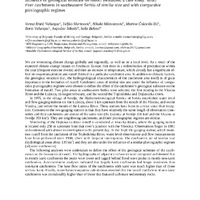Influence of geological substrate on runoff formation, a case study: small river catchments in southeastern Serbia of similar size and with comparable pluviographic regimes
Објеката
- Тип
- Саопштење са скупа штампано у изводу
- Верзија рада
- објављена
- Језик
- енглески
- Креатор
- Vesna Ristić Vakanjac, Veljko Marinović, Nikola Milovanović, Marina Čokorilo Ilić, Boris Vakanjac, Jugoslav Nikolić, Saša Bakrač
- Извор
- XXII International Congress of the Carpathian Balkan Geological Association (CBGA)
- Уредник
- Irena Peytcheva, Anna Lazarova, Georgi Granchovski, Rositsa Ivanova, Iskra Lakova, Lubomir Metodiev
- Издавач
- Sofia : Bulgarian Academy of Sciences
- Датум издавања
- 2022
- Сажетак
-
We are witnessing climate change that is happening both, globally and, at the regionally - or local level. As a result of expected climate change in Southeast Europe, in the first place are the distributions of precipitation within the year (frequent extreme events are present) and then the increase in temperature, which already has a significant impact on evapotranspiration and runoff formed in a particular catchment area. In addition to climatic factors, the geological structure, i.e. the hydrogeological characteristics of the catchment area itself, is of great importance in the formation of runoff. For the purpose of defining the influence of the catchment’s geological substrate, in the formation of runoff, catchment areas with similar surface sizes and under the influence of a similar pluviographic regimes were chosen. Two pilot areas from southeastern Serbia were selected, the first relating to the Vlasina River and the Lužnica its largest tributary, and the second, the Toplodolska and Dojkinačka Rivers.
In 1955, in the village of Svodje, the Republic Hydrometeorological Service of Serbia established water level observations and flow measurements stations, on both rivers, on Lužnica, about 1 km upstream from the mouth of Vlasina, and at Vlasina, just before the confluence of the Lužnica River. Within these profiles, observations are carried out till today. Common to these two gauging stations is that they have relatively the same lengths of observation series and catchment areas are almost the same size (catchment area of the river Lužnica g.s. Svodje is 318 km2 and the river Vlasina, g.s. Svodje is 350 km2). They are neighboring catchments and they have similar pluviographic regimes.
Monitoring of the Dojkinačka River runoff are made in the profile of Visočka Ržana, which is located only 250 m upstream from the mouth of this river in Visočica. Observations on this gauging station began in 1981 and continue almost without interruption until today. On the profile of Topli Do, which controls the runoff from the basin of the Toplodolska river, water level observations and flow measurements have been performed since 1990, although in this profile there were frequent interruptions in the observations. The basins are of similar size (hydrological areas of the basins are about 135 km2) and are also under the influence of a similar pluviographic regime (adjacent basins). - почетак странице
- 217
- isbn
- 978-619-91305-4-4
- Просторно покривање
- Pirot
- Шира категорија рада
- М30
- Ужа категорија рада
- М34
- Права
- Отворени приступ
- Лиценца
- All rights reserved
- Формат
Vesna Ristić Vakanjac, Veljko Marinović, Nikola Milovanović, Marina Čokorilo Ilić, Boris Vakanjac, Jugoslav Nikolić, Saša Bakrač. "Influence of geological substrate on runoff formation, a case study: small river catchments in southeastern Serbia of similar size and with comparable pluviographic regimes" in XXII International Congress of the Carpathian Balkan Geological Association (CBGA), Sofia : Bulgarian Academy of Sciences (2022) М34
This item was submitted on 8. децембар 2022. by [anonymous user] using the form “Рад у зборнику радова” on the site “Радови”: http://drug.rgf.bg.ac.rs/s/repo
Click here to view the collected data.
